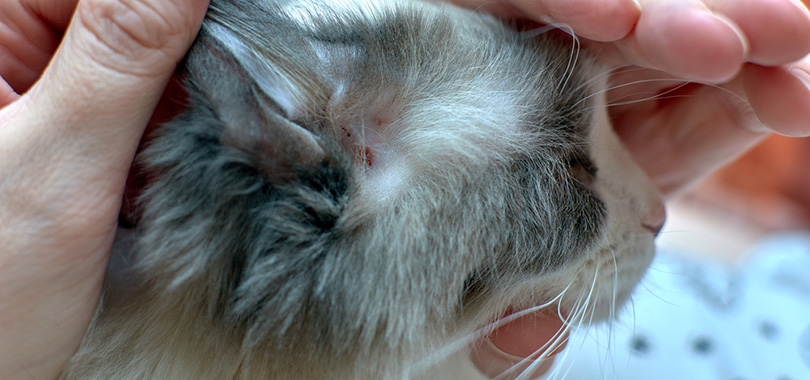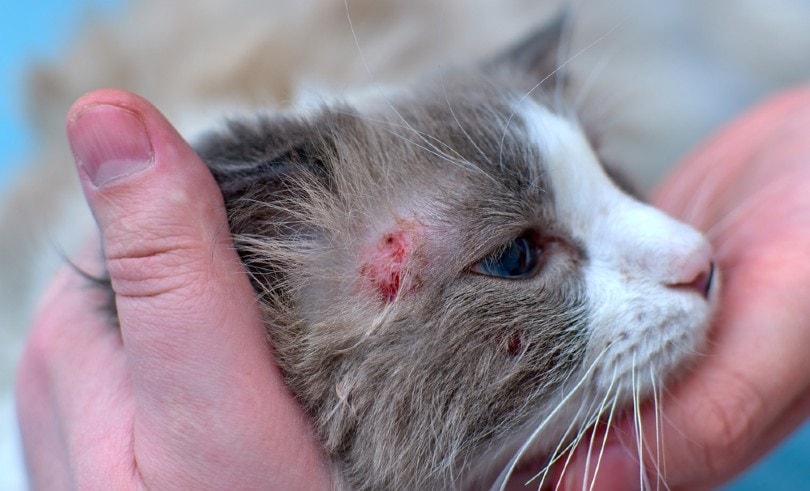How to Tell if a Cat Has Mange (Guide with Pictures)
Updated on

Mange is an uncomfortable disease for a cat to have. It can cause itching and pain, as well as secondary infections. It’s important to know how to identify if a cat has mange, especially if you rescue cats or keep outdoor cats. Here are the things you need to know about mange in cats.
What is Mange in Cats?
Mange is a set of skin diseases that are caused by mites. It is more common in dogs than cats, but it does occur in cats occasionally. Demodectic mange is the most common form and is not typically contagious, depending on the species. Demodex mites live on the skin of multiple mammals and are part of the healthy ecosystem of the epidermis.
However, cats with compromised immune systems due to age or medical conditions are at risk of an overgrowth of Demodex mites, leading to demodectic mange. Two types of Demodex mites affect cats: Demodex cati and Demodex gatoi. Demodex gatoi can be spread between cats, while Demodex cati can not.
Sarcoptic mange is an infectious type of mange that can be transmitted to humans caused by the Sarcoptes scabiei mite. Although the Sarcoptes mites do not live on human skin very long, they can be transmitted to humans and survive long enough to lead to itching, discomfort, and rashes. Sarcoptic mange is very uncomfortable and can lead to itching, pain, and large areas of raw, broken skin.
Notoedric mange is caused by Notoedres mites and only impacts cats. It is also sometimes referred to as feline scabies. It is contagious between cats and tends to start at the head and move downward, spreading across a cat’s body.
How to Tell if a Cat Has Mange
1. Watch for itching and behavior changes
Cats with mange will exhibit some level of itchiness. In more severe mange cases, cats may violently bite at their skin. Some cats may show other signs of discomfort, like lethargy, poor sleeping, hiding, inappetence, yowling, and even aggression.
2. Look for skin lesions and hair loss
Since mange causes cats to be itchy, they will typically have skin lesions or hair loss. With demodectic mange, there are usually patches of hair loss with scaly skin. With sarcoptic mange, the hair loss is typically patchy, but the skin may show signs of rashes, and there are often crusty, painful sores on the skin. Notoedric mange leads to hair loss and thickened, scaly skin, starting with the head and moving down the body.
3. Go to the vet
If you suspect your cat has any form of mange, a trip to the vet is necessary. Multiple skin conditions can lead to mange-like signs, from bacterial and fungal infections to cancers and allergies. Your vet will be able to get a sample of skin cells from your cat and view them under a microscope, allowing them to see the mites if mange is present.
Demodectic mange mites are cigar-shaped mites that are almost worm-like in their appearance. Sarcoptic mange mites are oval-shaped mites that are light in color. Notoedric mange mites are more rounded than the other two types of mites.
All three mites are relatively easy to identify under a microscope. Sarcoptic and notoedric mites are closely related and have a somewhat similar appearance, but your vet is likely to be able to detect the subtle differences.
How to Care for a Cat with Mange
Once your vet determines which type of mange your cat has and ensures no other medications are needed for secondary infections, they’ll provide you with a course of treatment. There are different types of mange treatments depending on the type of mange your cat has, so it’s essential for your vet to be involved in the diagnosis and treatment process.
The broken skin caused by scratching and rashes can sometimes lead to secondary infections. Your cat’s vet will be able to determine if a secondary bacterial, fungal, or parasitic infection has settled into the skin and prescribe appropriate medications to treat it. Cats can have multiple types of mange at the same time, but it is uncommon.
Conclusion
If you suspect your cat may have mange of any kind, it’s essential to have them seen by a veterinarian. They can provide an accurate diagnosis and prescribe an effective treatment for the care of your cat. If you attempt to diagnose and treat mange on your own at home, you may do more harm than good by further interrupting the natural functions of your cat’s skin and immune system.
By keeping your cat indoors, you’ll significantly reduce the risk of your cat developing mange in their lifetime. If you suspect your cat may have mange, wash your hands well after handling or medicating them. You should also thoroughly wash or replace items like bedding and toys harboring mange mites. This is especially important with contagious forms of mange.
See also:
- How to Stop a Cat from Spilling Their Water Bowl (8 Ways)
- How To Attach Carpet To A Cat Tree (Reupholstering A Cat Tree)
Featured Image Credit: eremeevdv, Shutterstock















